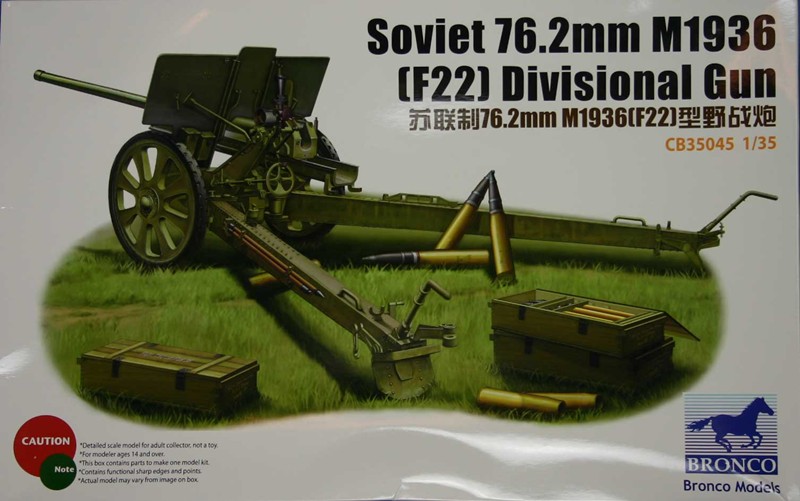Soviet 76.2mm M1936 (F22) Divisional Gun
Sprues
- G – This sprue contains parts for the gun, shield, and gun cradle
- H x 2 – This has the wheel and hand wheels
- J – This has the ammo box and 3 shells
- N – This has the trails and associated bits
- P – Photo Etched parts
This kit is a representation of a Soviet “Divisional Gun” that was to fill the role of both a field gun and an anti-aircraft gun. This gun was designed in the early 1930s and started production in 1936. It stayed in production until 1939 when the Model 1939 gun went into production. May of these guns were captured and used by the German, Finnish, and Rumanian Armies.
Before starting the model, you need to decide how you want to display the gun, either in travel mode or firing mode. The instructions don’t do a very good job of showing you what the differences are during the build to make the two different versions. I will try to point these out as I go along.
Step1 consists of the assembly of the gun and gun cradle. Some of the parts are very small and delicate and require a lot of care to keep them from being damaged during the build. I left of part G13, the breech lever until very late in the construction to keep from breaking it off. You can show the breech in the open or closed position. The instructions say to not glue it, but on mine it was such a tight fit that glue was not necessary to hold it in the desired position.
Step 2 builds the gun carriage. There are several places in the instructions that say to not use glue, implying that the gun cradle will be moveable in the gun carriage. However, other parts such as G44, the elevation gear, are shown glued in place, thereby keeping the gun from any movement. There are several small parts to be added in this step, such as the turning handle on the hand wheels. I added these to the hand wheel, but opted to leave the hand wheel off until later in the build. The recuperating cylinders are made up of five parts and they don’t line up very well. Take time to ensure that they are straight. They are very apparent when you view the finished model from the front.
Step 3 is the building of the gun shield and mounting it to the gun carriage. This step is straightforward and no complications are apparent.
Step 4 starts out with building the ammo box and the 3 shells therein. The instructions go into great detail on how to build the box and its lid. However, there is a problem with the lid. The molded on hinges and clasps show the box only in the closed position. You can show the box open, thereby displaying the shells, but the clasp will be missing from the side of the box. Most people will not notice this, but it is not correct.
The rest of this step is concerned with the construction of the two trailing arms. If you are careful in gluing parts G54 and G55, the axle between the upper and lower pieces of the trailing arm, the arms will be movable. The instructions show part N3 arm adjustment lever as not being glued in and thereby being moveable. However, the fit is not a moveable one. You will need to decide if you want the arms in either travel mode or firing mode. I chose to show the model in firing mode so I glued these two levers in place as shown in Step 7. In this step most of the photo etched parts are added. The instructions have inserted computer generated pictures of how the photo etched parts should look after the bending is complete. Once again there are some very small parts added in this step. Part N12 is a very small handle attached to the spade locking lever.
Step 5 is the building of the wheel carriage and the attachment of the trailing arms. This step is a simple build, except for the attachment of parts G61 and G62 to part H6 and then to the carriage. These are the lower splinter shields and there is not much contact to allow for a firm attachment, especially if assembled all at the same time. I glued part H6 to the carriage and let it dry overnight. I then glued the parts G61 and G60 to part H6 and again let it dry overnight before doing anything else to the carriage. I did not attach the wheels until after I had painted them and the carriage along with a little weathering. This allowed me to get into those areas mostly hidden by the wheels, but still easily viewed thru the slots in the wheels.
Step 6 is the marriage of the gun carriage to the wheel carriage.
Step 7 shows the different positions you can display the model. The final parts are added here, as well as any parts you left off during the build.
Painting and Decals:
The color charts shows the reference numbers for Tamiya, Humbrol, Mr. Hobby, and Mr. Color. The paint schemes and associated decals are as follows:
Overall dark olive green – Surprise! Surprise! Surprise!
The decals have no manufacturer's name other than Bronco, so I have to assume that Bronco produced them themselves. They appear to be in register and they went on with out any fuss.
Conclusion:
The build is at an intermediate level with very good detail. The molding is crisp with no flash and minimal mold lines. I can recommend this kit to all artillery and Russian army fans.










Comments
Add new comment
This site is protected by reCAPTCHA and the Google Privacy Policy and Terms of Service apply.
Similar Reviews